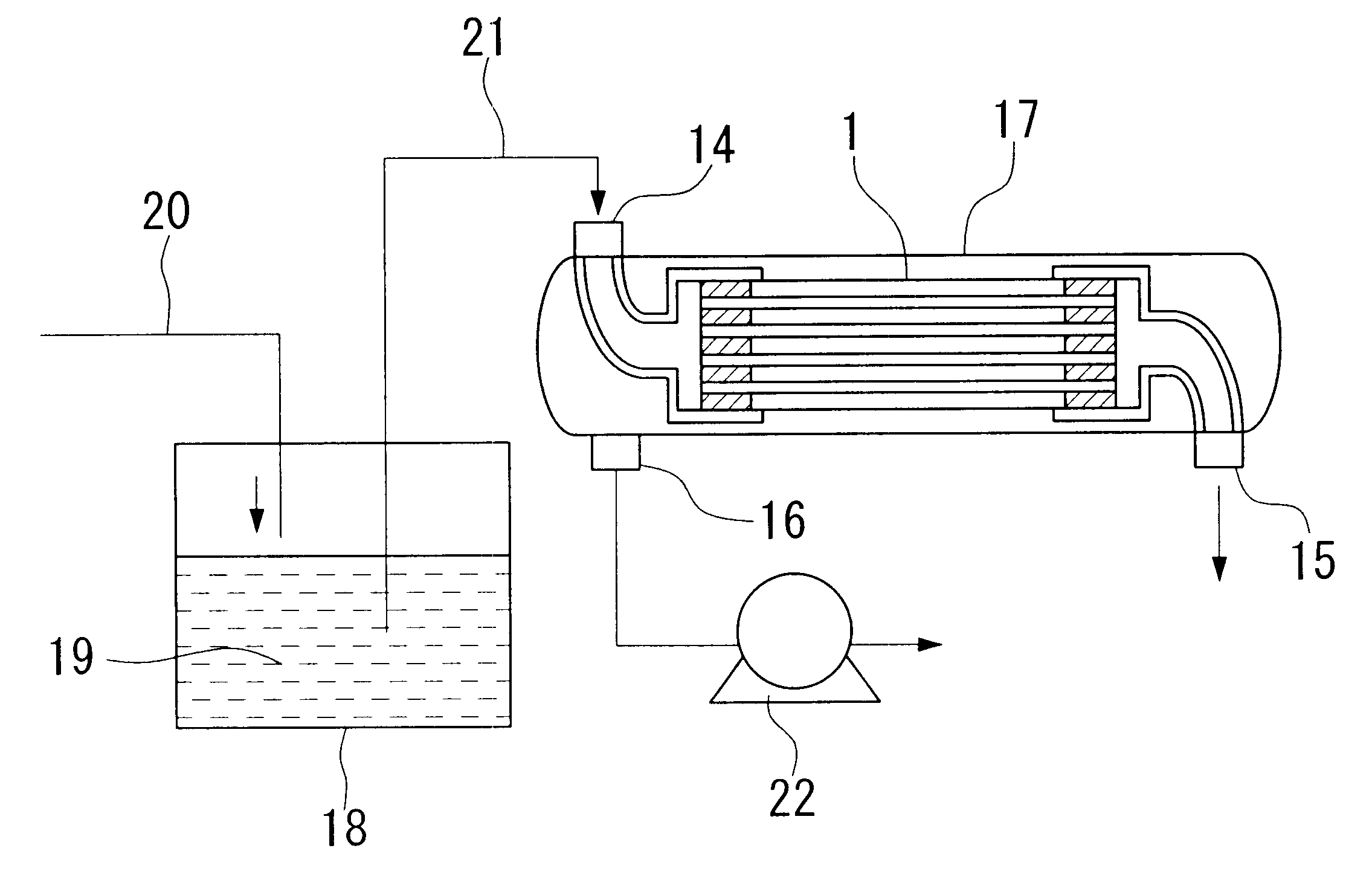Hollow yarn membrane module, potting agent therefor and method for deaeration of liquid chemicals
a technology of hollow fiber membrane module and potting agent, which is applied in the direction of liquid degasification by filtration, isotope separation, separation process, etc., can solve the problem that the potting material of a hollow fiber membrane module is low compatibility with solvent, and achieves superior chemical resistance
- Summary
- Abstract
- Description
- Claims
- Application Information
AI Technical Summary
Benefits of technology
Problems solved by technology
Method used
Image
Examples
embodiment 1
Polysulfide modified epoxy resin ("Flep 10", Toray Thiokol Co., Ltd.), bisphenol epoxy resin ("Epicote 828", Yuka Shell Epoxy Co., Ltd.) and aromatic polyamine curing agent ("Ankamine 1833", BTR Japan) were mixed at a weight ratio of 33.5:53.1:13.4 and then degassed to produce a resin plate. After allowing the resin plate to stand overnight at room temperature, it was cured by heating for 6 hours at 80.degree. C. The cured resin plate was cut to a size of 60.times.8.times.2 mm to produce a test piece of a chemical resistance test.
The results of a chemical resistance test on this potting material are shown in Tables 1 and 2. The chemical resistance test was performed by immersing the above test piece in various chemicals at 23.degree. C. followed by measurement of the weight change and rate of change in thickness after 3 and 6 months. In addition, metal contents are shown in Table 5.
embodiment 2
With the exception of mixing sorbitol polyglycidyl ether ("Erisys GE-60", BTR Japan), urethane modified epoxy resin ("TSR243", Dainippon Ink and Chemicals, Inc.) and alicyclic polyamine curing agent ("Ankamine 2049", BTR Japan) at a weight ratio of 38.0:38.0:24.0, a test piece was produced in the same manner as Embodiment 1.
The results of a chemical resistance test on this potting material are shown in Tables 1 and 2. The chemical resistance test was performed by immersing the above test piece in various chemicals at 23.degree. C. followed by measurement of the weight change and rate of change in thickness after 3 and 6 months. In addition, metal contents are shown in Table 5.
embodiment 3
With the exception of mixing the above "Epicote 828", "Erisys GE-60" and "Ankamine 1833" at a weight ratio of 44.0:39.4:16.6, a test piece was produced in the same manner as Embodiment 1. The results of a chemical resistance test on this potting material are shown in Tables 1 and 2. The chemical resistance test was performed by immersing the above test piece in various chemicals at 23.degree. C. followed by measurement of the weight change and rate of change in thickness after 3 and 6 months. In addition, metal contents are shown in Table 5.
PUM
| Property | Measurement | Unit |
|---|---|---|
| weight change ratio | aaaaa | aaaaa |
| thickness | aaaaa | aaaaa |
| thickness | aaaaa | aaaaa |
Abstract
Description
Claims
Application Information
 Login to View More
Login to View More - R&D
- Intellectual Property
- Life Sciences
- Materials
- Tech Scout
- Unparalleled Data Quality
- Higher Quality Content
- 60% Fewer Hallucinations
Browse by: Latest US Patents, China's latest patents, Technical Efficacy Thesaurus, Application Domain, Technology Topic, Popular Technical Reports.
© 2025 PatSnap. All rights reserved.Legal|Privacy policy|Modern Slavery Act Transparency Statement|Sitemap|About US| Contact US: help@patsnap.com



